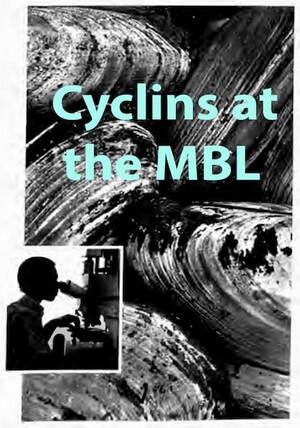Cyclins are a group of proteins that control the progression of the cell cycle by activating particular enzymes—cyclin dependent kinases. Those kinases act on different protein structures that play large roles in the cell cycle. For example, one kinase in humans activates the proteins that carry out DNA replication. Without the cyclin that activates the kinase, DNA replication could not occur and cells would be unable to proliferate.
There are many types of cyclins, all of which activate different kinases that play different roles in the cell cycle. Organisms vary in their numbers and types of cyclins, which are distinguished by their protein structures.. Proteins are made of chains of amino acids that fold in specific ways to fit with other molecules – like a lock and key. The structure of a cyclin is exactly matched to the structure of the kinase it activates, which ensures that the right kinase is activated at the correct time during the cell cycle and that the cell cycle progresses in the correct order.
Proteins have four levels of organization – primary, secondary, tertiary, and quaternary. The primary structure of a protein is its amino acid sequence. The amino acid sequence of different cyclins varies; however, there is a conserved 100 amino acid chain known as the ‘cyclin box’,in all cyclins (Branden, 1999: 108). The secondary, tertiary, and quaternary structure of proteins refer to different levels of protein folding, which create the three dimensional structure of the protein.
What are Cyclins?
- Branden, C. I. (1999). Introduction to Protein Structure. New York: Garland Science. - https://books.google.com/books?id=eUYWBAAAQBAJ&pg=PA107&lpg=PA107&dq=domain+structure+of+cyclins&source=bl&ots=Pz5XNBd3kZ&sig=n2O3Cw0Vr8GmvuV0y-KF6i0PfYw&hl=en&sa=X&ei=BQl3VfOqMu-HsQTY5YOwDQ&ved=0CGIQ6AEwCw#v=onepage&q=domain%20structure%20of%20cyclins&f=false
- Hershko, A. (1999). Mechanisms and regulation of the degradation of cyclin B. Philosophical Transactions of the Royal Society B: Biological Sciences, 354(1389), 1571-1576.
- Nobel Prize, 2001. http://www.nobelprize.org/nobel_prizes/medicine/laureates/2001/hunt-bio.html
Early Work with Cyclins
- Boveri, T. (1902). On multipolar mitosis as a means of analysis of the cell nucleus. Foundations of experimental embryology, 1964, 74-97.
- Franz, S. (2002). http://www.nature.com/celldivision/milestones/full/milestone02.html
- Greaves, S. (2002). http://www.nature.com/celldivision/milestones/full/milestone07.html
- Jackson, P.K. (2008). The Hunt for Cyclin. Cell, 134, 199-202
- MBL History Project. "Joan Ruderman Cyclin Research I." Filmed June 2015. MBL History Project Video, 5:58. Posted June 2015. http://history.archives.mbl.edu/node/16066.
- MBL History Project. "Joan Ruderman Cyclin Research II." Filmed June 2015. MBL History Project Video, 8:55. Posted June 2015. http://history.archives.mbl.edu/content/joan-ruderman-cyclin-research-ii-june-5-2015.
- Mitchell, A. (2002). http://www.nature.com/celldivision/milestones/full/milestone03.html
- Nath, D. (2002). http://www.nature.com/celldivision/milestones/full/milestone06.html
- Patterson, M. (2002). http://www.nature.com/celldivision/milestones/full/milestone05.html
- Rosenthal, E. T., Hunt, T., & Ruderman, J. V. (1980). Selective translation of mRNA controls the pattern of protein synthesis during early development of the surf clam, Spisula solidissima. Cell, 20(2), 487-494.
- Surridge, C. (2002). http://www.nature.com/celldivision/milestones/full/milestone01.html
Tim Hunt and His Discovery of Cyclin
- Evans, T., Rosenthal, E. T., Youngblom, J., Distel, D., & Hunt, T. (1983). Cyclin: a protein specified by maternal mRNA in sea urchin eggs that is destroyed at each cleavage division. Cell, 33(2), 389-396.
- Gerhart, J., Wu, M., & Kirschner, M. (1984). Cell cycle dynamics of an M-phase-specific cytoplasmic factor in Xenopus laevis oocytes and eggs. The Journal of Cell Biology, 98(4), 1247-1255.
- Hunt, T. (2001, December 9). Tim Hunt Nobel Lecture Protein Synthesis, Proteolysis, and Cell Cycle Transitions." Nobelprize.org. Retrieved from: http://www.nobelprize.org/nobel_prizes/medicine/laureates/2001/hunt-lecture.html
- Hunt, T. (2004). The Discovery of Cyclin (I). Cell, S116, S63-S64.
- Jackson, P.K. (2008). The Hunt for Cyclin. Cell, 134, 199-202
- Masui, Yoshio, and Clement L. Markert. "Cytoplasmic control of nuclear behavior during meiotic maturation of frog oocytes." Journal of Experimental Zoology Part A: Ecological Genetics and Physiology 177, no. 2 (1971): 129-145.
- Pulverer, B. (2002). http://www.nature.com/celldivision/milestones/full/milestone12.html
- Swenson, K. I., Farrell, K. M., & Ruderman, J. V. (1986). The clam embryo protein cyclin A induces entry into M phase and the resumption of meiosis in Xenopus oocytes. Cell, 47(6), 861-870.
Cyclins and Genetics
- Ciechanover, A., Finley, D., & Varshavsky, A. (1984). Ubiquitin dependence of selective protein degradation demonstrated in the mammalian cell cycle mutant ts85. Cell, 37(1), 57-66.
- Glotzer, M., Murray, A. W., & Kirschner, M. W. (1991). Cyclin is degraded by the ubiquitin pathway. Nature, 349(6305), 132-138.
- Goldstein, G., Scheid, M., Hammerling, U., Schlesinger, D. H., Niall, H. D., & Boyse, E. A. (1975). Isolation of a polypeptide that has lymphocyte-differentiating properties and is probably represented universally in living cells. Proceedings of the National Academy of Sciences, 72(1), 11-15.
- Gould, K. L. & Nurse, P. (1991). Tyrosine phosphorylation of the fission yeast cdc2+ protein kinase regulates entry into mitosis. Nature 342, 39-45.
- Greenwood, E. (2002). http://www.nature.com/celldivision/milestones/full/milestone09.html
- Hartwell, L. H., Culotti, J., Pringle, J. R., & Reid, B. J. (1974). Genetic control of the cell division cycle in yeast. Science, 183(4120), 46-51.
- Hershko, A. (1991). The ubiquitin pathway for protein degradation. Trends in biochemical sciences, 16, 265-268.
- Hershko, A. (1999). Mechanisms and regulation of the degradation of cyclin B. Philosophical Transactions of the Royal Society B: Biological Sciences, 354(1389), 1571-1576.
- Nature. (2004). A prize for protein degradation. Nature Cell Biology, 6(1011), doi:10.1038/ncb1104-1011.
- Nobel Prize 2001 http://www.nobelprize.org/nobel_prizes/medicine/laureates/2001/
- Nobel Prize 2004 http://www.nobelprize.org/nobel_prizes/chemistry/laureates/2004/ ; http://www.nobelprize.org/nobel_prizes/chemistry/laureates/2004/hershko-bio.html
- Nurse, P. (1975). Genetic control of cell size at cell division in yeast. Nature, 256, 547-551.
- Nurse, P., & Thuriaux, P. (1980). Regulatory genes controlling mitosis in the fission yeast Schizosaccharomyces pombe. Genetics, 96(3), 627-637.
- Patterson, M. (2002). http://www.nature.com/celldivision/milestones/full/milestone05.html
- Russell, P. & Nurse, P. (1986). cdc25+ functions as an inducer in the mitotic control of fission yeast. Cell 45, 145-153.
- Schoenheimer, R. (1942). The Dynamic State of Body Constitutents. Cambridge: Harvard University Press.
- Varshavsky, A. (2006). The early history of the ubiquitin field. Protein science, 15(3), 647-654.

